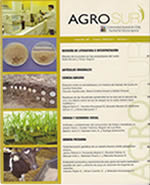Historical use of a Ñadi soil: consequences on the effective capacity to storage water/air and the continuity of the pore system
Main Article Content
Abstract
Volcanic soils present excellent physical properties. However, there is a group (Ñadi soils) that presents shallow depths, such that depending on the climate they can be waterlogged until completely dry. This work analyzes the effect of the land use change (CUS) on the effective soil depth of a Ñadi, and its consequences on the storage and conduction capacity of water and air of the pores. Undisturbed soil samples were collected at 5 and 15 cm depth of a Ñadi (Series Alerce) in the sector Tepual of Puerto Montt. The CUS from a native forest (BN) to naturalized grasslands (PN1 and PN2) occurred 35 years ago. The effective soil depth was measured and the saturated hydraulic conductivity (ks) as well as the soil water and air storage capacity was determined in terms of volume (%) and height (cm). The air capacity (CA) and permeability (ka) were recorded before and after the determination of ks. The depth for sites is 69(BN), 56(PN2) y 44(PN1). The depth determines the storage capacity of the soil, either of water and air, such that in decreasing order per site is BN˃PN2˃PN1. The ks and ka are in BN> PN1≈PN2. After the infiltration process, the ka did not undergo changes. On the contrary, the CA changed mainly in the prairies, which can be explained by a change in the volume of macropores but not in the continuity of the pore system.

